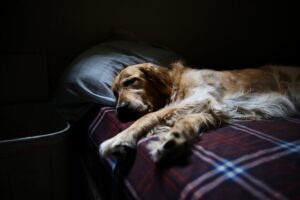It has been estimated that as many as 15-20% of pets suffer from some form of anxiety.
It is not uncommon for anxious dogs to refuse to sleep through the night on their own and instead need constant attention and reassurance from their human guardian.
This anxiously attached behaviour can severely affect the well-being of both dog and guardian.
Dogs who are anxiously attached are at much greater risk for developing separation anxiety, noise phobias, or other anxieties related to abandonment or being left alone.
It is for this reason that I always recommend finding a way to get your dog to sleep on their own for extended periods of time.
11 Ways To help when your dog can’t sleep without you
When people come to see me with their anxious dogs, the first thing we try to do is to get them sleeping on their own.
If your dog can sleep through the night in any way, please don’t change anything.
But if you are looking for ways to help your dog sleep better at night and can’t figure out how, here are some recommendations:
1) Buy a separate bed
The easiest way I have found for my anxious dogs who need me to lie next to them through the night is simply buying two beds.
Put one in your bedroom and the other in a different place in the house.
I have taught many anxious dogs to sleep on their own through helping them to associate another familiar place with being relaxed and sleeping.
2) Create a separate space
Another easy solution is finding a way to get your dog to sleep with you but not IN bed with you.
The benefit for you is that you have access to your dog throughout the night.
The benefit for your dog is that they are left in their own bed. This creates an association with being relaxed in their own bedroom.
3) Use a crate
The third option for anxiety dogs who cannot sleep on their own is the crate.
A crate is a device that will restrict your dog’s access to you while also leaving them in their own bed at night.
If you have a crate, either leave it in your bedroom and let your dog sleep in there, or set it up next to your bed and allow him free access to it.
This too can affect an anxious dog’s ability to feel safe and protected when they are not right next to you.
4) Make a ‘Doggy Door’
A fourth option is to create a doggy door in your bedroom door.
If you don’t have an existing doggy door, this is quite easy to make yourself.
All you need is a doggie flap (that goes over your bedroom door), two screws with hooks on the end of them and some rope or towel material.
Drill holes in the side of your bedroom door where you can secure the screws into it.
Attach hooks to the heads of the screws, then attach rope or towel material.
This will allow your dog to go through the door when they want but also keep it shut when needed for safety reasons at night.
5) Buy a new Dog Bed
A fifth, more sophisticated option is to get your dog a new doggy bed.
There are so many great beds on the market now that there is no shortage of choices for anxious dogs in this area.
I recommend a bed that has a heavy memory foam material inside and a non-restrictive outer cover.
6) Use a weighted blanket
A weighted blanket can be used in any bed for anxious dogs – it is completely weatherproof and only light enough to keep your dog’s head in an upward tilt.
The idea behind this exercise is that your dog will feel safe when lying down if they are lying on something that will not budge when they turn over.
Some trainers recommend attaching a low weight to the underside of the blanket right in between your dog’s front legs.
This way, when they lay down, their front legs will come up off of the blanket and create an upward-tilt out of their belly.
7) Create a barrier
Create a simple barrier with furniture.
If you have a space (either in the middle of the room or by your bed), you can use furniture to block your dog off from your bed during the night.
This is often done by putting one chair up against your bed and another chair facing it on the other side of the room.
With some fuzzy blankets tossed over the chairs, it makes an instant barrier that is highly effective with anxious dogs that do not like to be separated from you during the night.
8) Make a sleeping platform
This can be an actual sleeping platform, or you can purchase a sheet of fabric with Velcro attached to it and attach it to the sides of your bed.
The idea behind this piece is that dogs do not like feeling exposed on their sides when they are lying down on the floor.
This also makes them feel safer than if they were lying on the hard floor all night long.
9) Make a room divider
If your dog would prefer to stay in one room and not move into another room, you can purchase or build a small wooden lattice that attaches to the walls and keeps them within the perimeter of one room.
10) Create a ‘safe zone’
Another option is to create a “walled” safe-zone in your home by using baby gates or other barriers to confine your dog to one part of the house while keeping them away from doors and windows during the night.
This will create a special safe place where your dog can go to when it wants to sleep.
11) Use a calming product
Purchase a calming product from a pet store or online that you can give when you are away from home.
There are many different kinds of calming products, which can be used to help calm your dog when they are left alone.
This is a very cost-effective option for anxious dogs.
Don’t Give Up On Your Dog
If these options do not work for your dog, I strongly recommend seeking the help of a professional trainer in your area.
It takes time to understand the specific issues your dog may be having, but once you get there, your training will get easier – and faster.
Either way, please do not give up on your dog.
You must form that relationship with your dog based on what works best for that individual animal.
When you understand what works best for your dog, I promise that you will succeed at anything!
The good news about these options is that if any of these help your dog sleep better while also helping you, keep going!
The better news is that no matter what method works best for your situation, just keep trying different things until one or more of them calms your dog down.
I have tried all of these methods with anxious dogs. They are not perfect, but they are the greatest improvements that I have found to assist anxious dogs who can’t sleep on their own.
Give them a try and see how they work
Final Thoughts
If your dog cannot sleep without you, it is important to allow him to slowly make the transition on his own.
Very often, dogs who need to be together with their guardians at night can also suffer from separation anxiety.
This means that if you make the transition too quickly by force or by accident, the dog may flip into being anxious when left alone for any period of time.
Therefore please remember that if your dog cannot sleep alone, take it slow and be patient with the changes.
Dogs already have a hard time dealing with change on their own – making changes in their sleeping situation can create even more stress for them.
Resources

